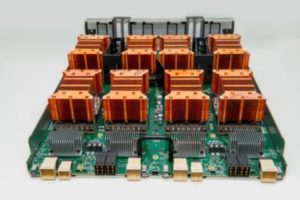AI-driven Diagnostics for Network of Boston-based Healthcare Providers

The Center for Clinical Data Science (CCDS), Boston, is at the confluence of major technology trends driving the healthcare industry: AI-based diagnostics of large volumes of medical images, shared among multiple medical institutions, utilizing GPU-based neural networks.
Founded by Massachusetts General Hospital and later joined by Brigham & Women’s Hospital, CCDS today announced it has received what it calls a purpose-built AI supercomputer from the portfolio of Nvidia DGX systems with Volta, said by Nvidia to be the biggest GPU on the market.
Later this month, CCDS will also receive a DGX Station, which Nvidia calls “a personal AI supercomputer,” that the organization will use to develop new training algorithms “and bring the power of AI directly to doctors” in the form of a desk-side system.
The idea is to provide Boston-area radiologists with AI “assistants” integrated into their daily workflows, helping them more quickly and accurately diagnose disease from MRIs, CAT scans, X-rays and other medical images. CCDS said the trained neural networks residing on DGX-1 systems in its data center “are in a constant state of learning, continually ingesting countless medical images worldwide.”
CCDS, Mass General and Brigham’s are Harvard Medical School teaching hospitals and founding members of Partners Healthcare, a Boston-based healthcare network that last April announced a collaboration with Persistent Systems to develop a shared-resource industry cloud – what the companies describe as an industry-wide open-source platform for knowledge exchange and development of decision support apps in clinical environments. The platform is based on SMART (open, standards-based technology platform for integration of apps with electronic health records) and FHIR (Fast Healthcare Interoperability Resources) developed by the Health Level-7 standards organization. The platform will enable provider systems to deploy “industry-leading best practices in clinical care across their ecosystems.”
CCDS's GPU-based diagnostics capability could play a significant role in that ecosystem.
“Because trained neural networks can provide superhuman pixel-by-pixel image evaluation and analyze scores of other data with incredible speed, doctors can make more accurate diagnoses and treatment plans,” stated CCDS in an Nvidia blog post. For example, radiologists reviewing medical images usually review them in the order in which they were received. “However, with AI-assisted imaging, it’s possible to triage the images, bringing the most troubling to the top of a radiologist’s queue.”
“Today’s practitioners have a barrage of data thrown at them — lab reports, MRIs, CAT scans, family health histories and more — which makes it incredibly difficult to make decisions,” said CCDS Executive Director Dr. Mark Michalski. “So, having technology that can aid them in this effort can be incredibly transformative.”
By all accounts, Volta is a processing powerhouse. Its architecture offers a new type of processor, Tensor Core, designed to accelerate AI workloads. With 640 Tensor Cores (8 per SM), the Tesla V100 delivers 120 teraflops of deep learning performance, providing 6-12 times higher peak teraflops for Tensor operations compared with previous-generation silicon, according to Nvidia.
Nvidia said the new DGX-1 with Volta delivers AI computing performance three times faster than the prior DGX generation, providing the performance of up to 800 CPUs in a single system. The DGX Station delivers the computing capacity of 400 CPUs, consuming nearly 40x less power, in a form factor that fits desk-side.











